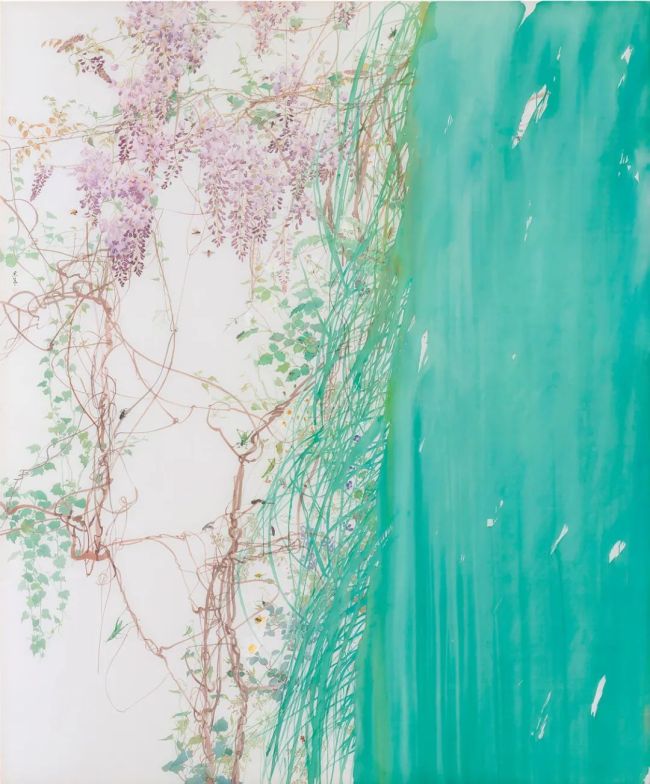李恩成的画作色彩斑斓却不轻浮。他擅长将“没骨法”与染色渲染相结合,用色彩表现植物的生长逻辑和精神状态。色在他手中,不是装饰,而是一种结构、一种节律。
以下内容摘自李恩成自述《窥情风景之上钻貌草木之中——我的花鸟画创作观》:
Li Encheng has devoted years to exploring how gongbi painting can both preserve classical brushwork spirit and develop new visual approaches and pictorial logic in contemporary practice. His works dazzle with vibrant hues yet never succumb to frivolity. He masterfully integrates the mogu (boneless) technique with delicate color washes, using pigment to articulate plants' growth patterns and spiritual essence. In his hands, color transcends mere ornamentation—it becomes structural architecture, living rhythm.
The following excerpts are from his artist statement "Observing Sentiment Beyond Landscape, Delving into the Essence of Flora—My Philosophy of Bird-and-Flower Painting":

《红瓜》
绢本设色70x35cm2021年
起拍价RMB12,000
写生是花鸟画家突破传统藩篱,找寻自我表现技法和题材的重要环节。五代黄筌的《写生珍禽图》和北宋赵昌的《写生蛱蝶图》早有先例,自古以来很多卓有成就的花鸟画家都是从写生中汲取新意,找寻突破的。写生的首要问题是要学会观察,不是简单的用眼睛去看,要用心体悟。易元吉为了画好猿猴,深入丛林,搭建棚屋,隐身期间,窥视猿猴的生活习性,打闹嬉戏,动态结构,从而成为一代画猴宗师,独树一帜。居巢的画尤重写生,他深入观察物象,常不分昼夜到户外细察草虫生态和跃动情状。高剑父称居廉“眼之所到,笔便能到,无物不写,无奇不写,前人不敢移入画面的东西,师尽能之”。居廉在写生时,“每将昆虫以针插腹部,或蓄诸玻璃箱,加之描写。画毕则以类似剥制的方法,以针钉于另一只玻璃箱内,一如今天的昆虫标本,仍时时观摩。”
"Sketching from life serves as a vital gateway for flower-and-bird painters to break through traditional confines and discover their own expressive techniques and subjects. Pioneering examples like Huang Quan’s Sketches of Rare Birds from the Five Dynasties and Zhao Chang’s Sketches of Butterflies from the Northern Song Dynasty demonstrate how masters throughout history drew innovation and breakthroughs from life-drawing. The foremost principle of sketching lies in learning to observe—not merely seeing with the eyes, but perceiving with the heart. To master painting gibbons, Yi Yuanji immersed himself in the jungle, dwelling in huts to secretly observe their habits, playful brawls, and dynamic postures, ultimately becoming an unparalleled master of primate portraiture. Ju Chao’s work placed extraordinary emphasis on life studies; he meticulously observed his subjects, often venturing outdoors day and night to examine the vitality and movements of insects and plants. Gao Jianfu praised Ju Lian: 'Where his gaze could reach, his brush could follow. Nothing escaped his depiction—no marvel was too unconventional, no subject too bold for his canvas.' When sketching, Ju Lian 'would pin insects through their abdomens or keep them in glass jars to depict them. After painting, he mounted them using methods similar to specimen mounting, pinning them in display cases—much like modern entomological specimens—for continual study.'

《红蜻蜓》
绢本设色70x35cm2021年
起拍价RMB12,000
我的写生是从身边寻常所见入手的。牵牛花、蜀葵,凤仙花,柳叶桃,白玉簪,马唐草,它们各具情态,色彩直接涂写,以写意性的笔法进入才能使线条不板不滞,花的形态千变万化,含苞待放吐露生机、半遮半掩娇羞欲语,全面盛开热情奔放,表现出花的万般风情。叶的形态务求统一,从形到色尽量少些变化来衬托花的丰富多彩,也可适当有个别叶梢枯黄或带虫眼的以破除叶的单调。草的画法更应自由,充分发挥毛笔的书写性,长短阔窄交替穿插,不必拘泥于一笔长,两笔短,三笔破凤眼的画法,而是要在群草叠加中追求野蛮生长所具有的疏密聚散的自然状态和坚韧不拔的生命力量。
My sketches begin with the ordinary wonders around me—morning glories, hollyhocks, garden balsams, oleanders, fragrant plantain lilies, crabgrasses—each possessing its own spirit. I apply colors directly with freehand brushstrokes, allowing lines to dance without rigidity. Flowers transform endlessly: buds bursting with nascent life, half-blooms shyly veiled as if whispering, full blossoms exuding untamed passion—thus capturing flora's myriad charms. For leaves, I seek uniformity in form and hue, minimizing variation to frame the flowers' splendor, yet sparingly add withered tips or insect-bitten holes to disrupt monotony. Grasses demand even greater freedom: unleashing the brush's calligraphic essence, interweaving long-short, broad-narrow strokes. I reject rigid formulas like 'one long, two short, three strokes piercing the phoenix eye', instead pursuing the untamed rhythm of clustered growth—dense and sparse, gathered and scattered—echoing nature's chaotic vitality and tenacious life force.

《山花烂漫》